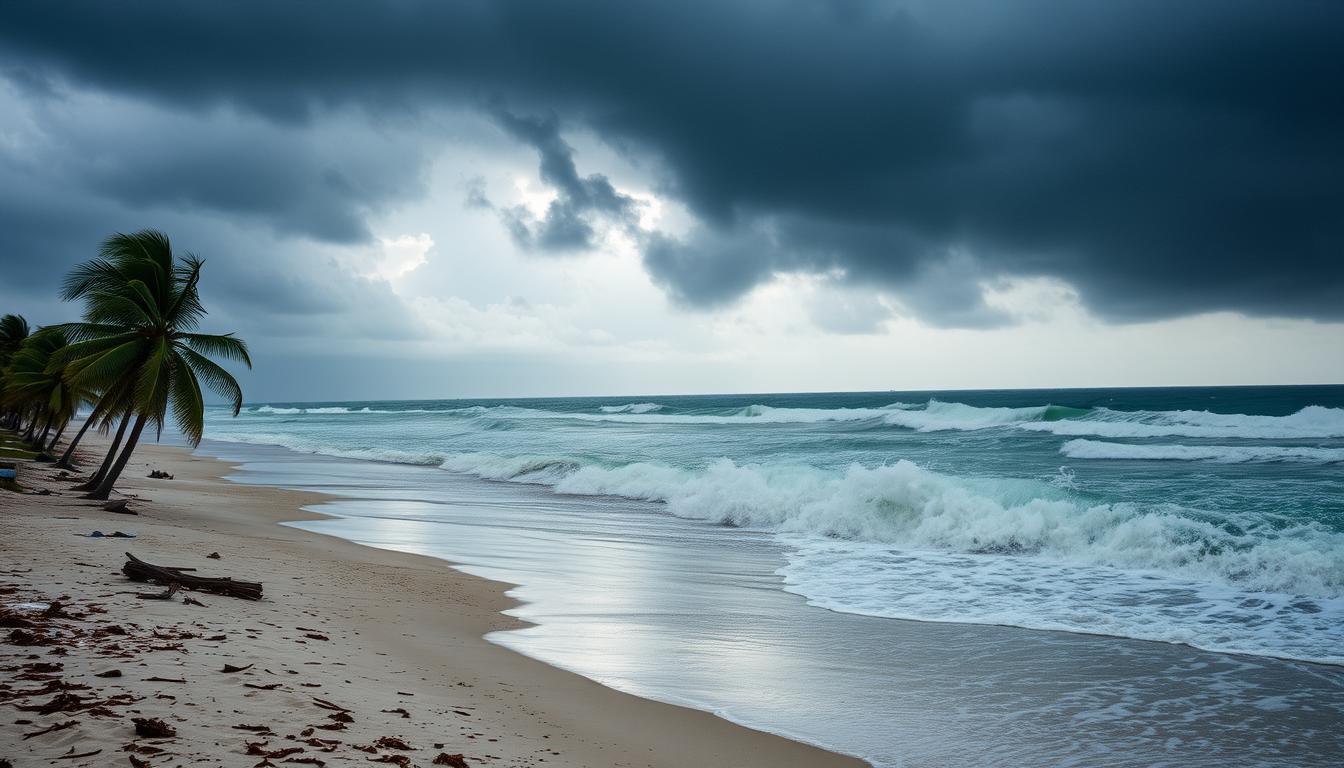Hurricane Helene hit Florida’s Big Bend region as a Category 4 storm at 11:10 p.m. ET on Thursday. It had winds of 140 mph, making it the first Category 4 storm to hit this area since 1859, reports say. The storm brought strong winds and heavy rain, posing a threat to life.
The Florida coast from Tampa to Cedar Key saw storm surges of 6 to 9.5 feet. Places like Cedar Key, Clearwater Beach, St. Petersburg, and Old Port Tampa set new records. In Perry, Florida, wind gusts hit 99 mph.
More than 1.2 million Floridians lost power due to the hurricane. Gulf Coast towns, especially Perry and Taylor County, faced widespread damage. Homes were flipped, siding was torn off, and power was out everywhere.
Key Takeaways
- Hurricane Helene made landfall as a Category 4 storm in Florida’s Big Bend region, the first since 1859.
- The hurricane brought record storm surges and fierce wind gusts, causing widespread damage.
- Over 1.2 million Florida residents were left without power in the wake of the storm.
- Significant destruction was reported in Perry and throughout Taylor County, Florida.
- Gulf Coast towns experienced flipped-over homes, torn-off siding, and extensive power outages.
The Path of Destruction
Hurricane Helene was a Category 4 storm that hit the Big Bend region of Florida. It brought 140 mph winds, the first Category 4 storm to do so since 1859. The storm destroyed many areas along the nature coast, affecting small towns and historic downtowns.
The storm caused over 1 million power outages in Florida. Neighboring states like Georgia and North Carolina also lost power, with 46,000 and 12,400 customers affected. Sadly, two people died in Georgia, and at least six lost their lives across the affected states.
As Helene moved north, it weakened but still caused significant damage. An estimated 42 million people were under flood alerts. Major cities like Charleston and Charlotte prepared for the storm’s impact.
| State | Power Outages |
|---|---|
| Florida | Over 1 million |
| Georgia | Over 46,000 |
| North Carolina | Over 12,400 |
| South Carolina | Almost 45% of homes and businesses |
The storm’s winds caused major delays at airports like Atlanta. Rainfall was heavy, with 15.5 inches in Sumatra, Florida. Flash flood warnings were issued in Georgia, North Carolina, and South Carolina.
Residents faced many challenges after the storm, including power outages and property damage. Emergency workers worked hard to clear debris and help those in need. As the area recovers, it’s important for people to know about their rights and available resources, like privacy policies and disaster relief programs.
Immediate Impact
Hurricane Helene hit the southeastern United States hard, causing destruction and chaos. It made landfall in Perry, Florida, with winds of 140 mph. The storm then moved into Georgia, bringing strong winds and heavy rain.
Millions of people saw their outdoor adventures, hunting spots, and fishing areas destroyed. The storm’s power outages were a major issue. By Friday morning, nearly 1.2 million customers were without electricity.
In Tallahassee, Florida, the situation was very bad. The city had 883 outages, affecting 52,724 customers. Talquin Electric’s map showed 17,080 outages in Leon County, about 66% of its customers.
The storm damaged roads and buildings with fallen trees and debris. In Tallahassee, 50 roads were blocked by trees. This made it hard for emergency teams to reach people and left many stranded.
People went to county shelters for safety, with 1,600 in them. Taylor County was hit hard, being the third hurricane in 13 months. The storm’s 140-mph winds left a lasting impact on the area.
The waters in Cedar Key rose to 8.5 feet, showing the storm’s power. Over a million power outages were reported in Florida. In Leon County, more than 60,000 customers lost power, dealing with the storm’s aftermath.
Emergency Response
When Hurricane Helene hit Florida’s coast, emergency teams quickly jumped into action. They focused on areas like Perry, Florida, and Taylor County. The Perry police chief wished he had urged more people to leave flood zones, as homes were at risk.
The Taylor County sheriff had warned people before the storm. He asked those who stayed to mark themselves with their names and details. This was to help find them if needed. Emergency responders faced many challenges, like downed power lines and flooded roads.
| Location | Wind Gusts (mph) | Storm Surge (feet) |
|---|---|---|
| Perry, Florida | 99 | 15+ |
| Cedar Key, Florida | 85 | 6 to 9.5 |
| Augusta, Georgia | 83 | N/A |
Hurricane Helene’s effects were felt far beyond Florida. Flash flood warnings were issued in Georgia, North Carolina, and South Carolina. Over 3.5 million people lost power, with Florida, Georgia, and South Carolina hit the hardest.
Local teams worked hard to help those affected. In South Carolina, the Bluffton Township Fire District got 118 calls in one day. The Beaufort County Sheriff’s office warned about dangers, and many roads were closed.
Aftermath and Recovery
As the sun rose over the Sunshine State, Gulf Coast towns faced the damage from Hurricane Helene. The storm, a Category 4 with 140 mph winds, left a trail of destruction. Governor Ron DeSantis reported at least one death, with more damage to come.
In Steinhatchee, a coastal town, water levels hit about 10 feet late Thursday. The storm surge was so strong, it moved entire mobile homes. This storm broke records, surpassing Hurricane Idalia’s from August 2023.
The hurricane’s effects were felt beyond Florida. In Valdosta, Georgia, drivers had to dodge fallen trees. Tarpon Springs, Florida, saw streets flooded. In Hernando Beach and Hudson, Florida, boats were found in the middle of roads.
| State | Homes and Businesses Without Power |
|---|---|
| Florida | 885,000+ |
| South Carolina | 45% |
| Greenwood County, SC | Nearly all 28,000 |
Millions were left without power in Florida, Georgia, and South Carolina. In Greenwood County, South Carolina, almost all homes and businesses lost power.
Recovery efforts are underway, with teams like the Ohio Task Force 1 helping. In Venice, Florida, 30 people were rescued from coastal areas. This shows the ongoing efforts to help those affected by Hurricane Helene.
Environmental and Economic Impact
Hurricane Helene has hit Florida hard, especially the Nature Coast. This area is famous for its natural beauty and outdoor fun. The storm’s high tides have damaged the coast, eroding beaches and roads.
The Lower Suwannee National Wildlife Refuge has been badly hit. It’s a huge area with a big river estuary. The 246-mile Lower Suwanee River is now flooded, hurting fishing and hunting. Steinhatchee Falls, Florida’s widest waterfall, has also been damaged.
The storm’s economic effects will be big, especially for fishing, hunting, and tourism. These industries draw visitors worldwide. Now, they face big challenges. To help, visit LatestUpdate.net for updates and ways to assist.
Recovering from Hurricane Helene will take time. The Nature Coast’s ecosystems and tourism need help. Protecting these natural wonders is key to the region’s future.











